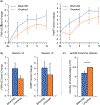Motor Activated Auricular Vagus Nerve Stimulation as a Potential Neuromodulation Approach for Post-Stroke Motor Rehabilitation: A Pilot Study
- PMID: 37209010
- PMCID: PMC10363288
- DOI: 10.1177/15459683231173357
Motor Activated Auricular Vagus Nerve Stimulation as a Potential Neuromodulation Approach for Post-Stroke Motor Rehabilitation: A Pilot Study
Abstract
Background: Implanted vagus nerve stimulation (VNS), when synchronized with post-stroke motor rehabilitation improves conventional motor rehabilitation training. A non-invasive VNS method known as transcutaneous auricular vagus nerves stimulation (taVNS) has emerged, which may mimic the effects of implanted VNS.
Objective: To determine whether taVNS paired with motor rehabilitation improves post-stroke motor function, and whether synchronization with movement and amount of stimulation is critical to outcomes.
Methods: We developed a closed-loop taVNS system for motor rehabilitation called motor activated auricular vagus nerve stimulation (MAAVNS) and conducted a randomized, double-blind, pilot trial investigating the use of MAAVNS to improve upper limb function in 20 stroke survivors. Participants attended 12 rehabilitation sessions over 4-weeks, and were assigned to a group that received either MAAVNS or active unpaired taVNS concurrently with task-specific training. Motor assessments were conducted at baseline, and weekly during rehabilitation training. Stimulation pulses were counted for both groups.
Results: A total of 16 individuals completed the trial, and both MAAVNS (n = 9) and unpaired taVNS (n = 7) demonstrated improved Fugl-Meyer Assessment upper extremity scores (Mean ± SEM, MAAVNS: 5.00 ± 1.02, unpaired taVNS: 3.14 ± 0.63). MAAVNS demonstrated greater effect size (Cohen's d = 0.63) compared to unpaired taVNS (Cohen's d = 0.30). Furthermore, MAAVNS participants received significantly fewer stimulation pulses (Mean ± SEM, MAAVNS: 36 070 ± 3205) than the fixed 45 000 pulses unpaired taVNS participants received (P < .05).
Conclusion: This trial suggests stimulation timing likely matters, and that pairing taVNS with movements may be superior to an unpaired approach. Additionally, MAAVNS effect size is comparable to that of the implanted VNS approach.
Keywords: MAAVNS; motor activated auricular vagus nerve stimulation; motor rehabilitation; stroke; tVNS; taVNS; transcutaneous auricular vagus nerve stimulation.
Conflict of interest statement
Declaration of Conflicting Interest
All other authors have no conflicts to report.
Figures



Similar articles
-
Design and validation of a closed-loop, motor-activated auricular vagus nerve stimulation (MAAVNS) system for neurorehabilitation.Brain Stimul. 2020 May-Jun;13(3):800-803. doi: 10.1016/j.brs.2020.02.028. Epub 2020 Feb 27. Brain Stimul. 2020. PMID: 32289710 Free PMC article.
-
Transcutaneous Auricular Vagus Nerve Stimulation (tAVNS) Delivered During Upper Limb Interactive Robotic Training Demonstrates Novel Antagonist Control for Reaching Movements Following Stroke.Front Neurosci. 2021 Nov 25;15:767302. doi: 10.3389/fnins.2021.767302. eCollection 2021. Front Neurosci. 2021. PMID: 34899170 Free PMC article.
-
Transcutaneous Auricular Vagus Nerve Stimulation with Concurrent Upper Limb Repetitive Task Practice for Poststroke Motor Recovery: A Pilot Study.J Stroke Cerebrovasc Dis. 2018 Jul;27(7):1998-2005. doi: 10.1016/j.jstrokecerebrovasdis.2018.02.056. Epub 2018 Mar 23. J Stroke Cerebrovasc Dis. 2018. PMID: 29580658 Clinical Trial.
-
Clinical Research Progress of the Post-Stroke Upper Limb Motor Function Improvement via Transcutaneous Auricular Vagus Nerve Stimulation.Neural Plast. 2023 Sep 25;2023:9532713. doi: 10.1155/2023/9532713. eCollection 2023. Neural Plast. 2023. PMID: 37789954 Free PMC article. Review.
-
Transcutaneous vagus nerve stimulation (tVNS) in stroke: the evidence, challenges and future directions.Auton Neurosci. 2022 Jan;237:102909. doi: 10.1016/j.autneu.2021.102909. Epub 2021 Nov 14. Auton Neurosci. 2022. PMID: 34861612 Review.
Cited by
-
Neuromodulation technologies improve functional recovery after brain injury: From bench to bedside.Neural Regen Res. 2026 Feb 1;21(2):506-520. doi: 10.4103/NRR.NRR-D-24-00652. Epub 2024 Dec 7. Neural Regen Res. 2026. PMID: 39851132 Free PMC article.
-
Brain‑heart axis: Neurostimulation techniques in ischemic heart disease (Review).Int J Mol Med. 2025 Oct;56(4):148. doi: 10.3892/ijmm.2025.5589. Epub 2025 Jul 19. Int J Mol Med. 2025. PMID: 40682847 Free PMC article. Review.
-
The efficacy and safety of bilateral synchronous transcutaneous auricular vagus nerve stimulation for prolonged disorders of consciousness: a multicenter, double-blind, stratified, randomized controlled trial protocol.Front Neurol. 2024 May 31;15:1418937. doi: 10.3389/fneur.2024.1418937. eCollection 2024. Front Neurol. 2024. PMID: 38882693 Free PMC article.
-
Closed-loop transcutaneous auricular vagus nerve stimulation for the improvement of upper extremity motor function in stroke patients: a study protocol.Front Neurol. 2024 Jun 5;15:1379451. doi: 10.3389/fneur.2024.1379451. eCollection 2024. Front Neurol. 2024. PMID: 38903173 Free PMC article.
-
A narrative review of vagus nerve stimulation in stroke.J Cent Nerv Syst Dis. 2024 Dec 13;16:11795735241303069. doi: 10.1177/11795735241303069. eCollection 2024. J Cent Nerv Syst Dis. 2024. PMID: 39677973 Free PMC article. Review.
References
-
- Tsao CW, Aday AW, Almarzooq ZI, et al. Heart disease and stroke statistics-2022 update: a report from the American Heart Association. Circulation. 2022;145(8):e153–e639. - PubMed
Publication types
MeSH terms
Grants and funding
LinkOut - more resources
Full Text Sources
Medical

